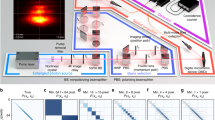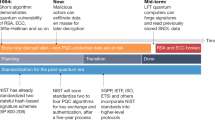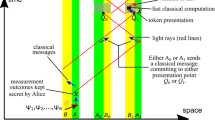Abstract
Among those who make a living from the science of secrecy, worry and paranoia are just signs of professionalism. Can we protect our secrets against those who wield superior technological powers? Can we trust those who provide us with tools for protection? Can we even trust ourselves, our own freedom of choice? Recent developments in quantum cryptography show that some of these questions can be addressed and discussed in precise and operational terms, suggesting that privacy is indeed possible under surprisingly weak assumptions.
This is a preview of subscription content, access via your institution
Access options
Subscribe to this journal
Receive 51 print issues and online access
$199.00 per year
only $3.90 per issue
Buy this article
- Purchase on Springer Link
- Instant access to full article PDF
Prices may be subject to local taxes which are calculated during checkout

Similar content being viewed by others
References
Poe, E. A. A few words on secret writing. Graham’s Mag. 19, 33–38 (1841)
Kahn, D. The Codebreakers: The Comprehensive History of Secret Communication from Ancient Times to the Internet (Scribner, 1996)
Rivest, R., Shamir, A. & Adleman, L. A method for obtaining digital signatures and public-key cryptosystems. Commun. ACM 21, 120–126 (1978)
Shor, P. W. Polynomial-time algorithms for prime factorization and discrete logarithms on a quantum computer. SIAM J. Comput. 26, 1484–1509 (1997)
Vernam, G. S. Cipher printing telegraph systems for secret wire and radio telegraphic communications. J. Am. Inst. Electr. Eng. 45, 109–115 (1926)
Bennett, C. H. & Brassard, G. in Proc. IEEE Int. Conf. Computer Syst. Signal Process. 175–179 (IEEE, 1984)This work reported key distribution based on encoding information in complementary bases.
Ekert, A. K. Quantum cryptography based on Bell’s theorem. Phys. Rev. Lett. 67, 661–663 (1991)This work reported key distribution based on quantum entanglement.
Fung, C.-H. F., Qi, B., Tamaki, K. & Lo, H.-K. Phase-remapping attack in practical quantum-key-distribution systems. Phys. Rev. A 75, 032314 (2007)
Lydersen, L. et al. Hacking commercial quantum cryptography systems by tailored bright illumination. Nature Photon. 4, 686–689 (2010)
Weier, H. et al. Quantum eavesdropping without interception: an attack exploiting the dead time of single-photon detectors. New J. Phys. 13, 073024 (2011)
Gerhardt, I. et al. Full-field implementation of a perfect eavesdropper on a quantum cryptography system. Nature Commun. 2, 349 (2011)
Bell, J. S. Speakable and Unspeakable in Quantum Mechanics: Collected Papers on Quantum Philosophy (Cambridge Univ. Press, 2004)
Colbeck, R. & Renner, R. No extension of quantum theory can have improved predictive power. Nature Commun. 2, 411 (2011)
Mayers, D. & Yao, A. in FOCS ‘98: Proc. 39th Annu. Symp. Foundations Computer Sci. 503–509 (IEEE, 1998)This work included a proposal for self-testing cryptographic devices.
Acín, A. et al. Device-independent security of quantum cryptography against collective attacks. Phys. Rev. Lett. 98, 230501 (2007)This work included a proposal for device-independent quantum key distribution.
McKague, M. Quantum Information Processing With Adversarial Devices PhD thesis, Univ. Waterloo (2010)
Hänggi, E. & Renner, R. Device-independent quantum key distribution with commuting measurements. Preprint at. http://arxiv.org/abs/1009.1833 (2010)
Masanes, L., Pironio, S. & Acin, A. Secure device-independent quantum key distribution with causally independent measurement devices. Nature Commun. 2, 238 (2011)
Vazirani, U. & Vidick, T. in ITCS ‘14: Proc. 2014 Conf. Innovations Theor. Computer Sci. (ed, Naor, M. ). 35–36 (ACM, 2012)
Reichardt, B. W., Unger, F. & Vazirani, U. Classical command of quantum systems. Nature 496, 456–460 (2013)
Barrett, J., Hardy, L. & Kent, A. No signaling and quantum key distribution. Phys. Rev. Lett. 95, 010503 (2005)This work demonstrated that the security of entanglement-based key distribution can be guaranteed without relying on the correctness of quantum theory.
Acín, A., Gisin, N. & Masanes, L. From Bell’s theorem to secure quantum key distribution. Phys. Rev. Lett. 97, 120405 (2006)
Masanes, L. Universally composable privacy amplification from causality constraints. Phys. Rev. Lett. 102, 140501 (2009)
Hänggi, E., Renner, R. & Wolf, S. in Advances in Cryptology – EUROCRYPT 2010 Vol. 6110 (ed. Gilbert, H. ) 216–234 (Springer, 2010)
Koh, D. E. et al. Effects of reduced measurement independence on Bell-based randomness expansion. Phys. Rev. Lett. 109, 160404 (2012)
Colbeck, R. & Renner, R. Free randomness can be amplified. Nature Phys. 8, 450–454 (2012)This work proved that randomness amplification is possible.
Gallego, R. et al. Full randomness from arbitrarily deterministic events. Nature Commun. 4, 2654 (2013)
Brandao, F. et al. Robust device-independent randomness amplification with few devices. Preprint at. http://arxiv.org/abs/1310.4544 (2013)
Khalfi, L. A. & Tsirelson, B. S. in Symp. Foundations Mod. Phys. (eds Lahti, P. & Mittelstaedt, P. ) 441–460 (World Scientific, 1985)
Popescu, S. & Rohrlich, D. Quantum nonlocality as an axiom. Found. Phys. 24, 379–385 (1994)
Cirel’son, B. Quantum generalizations of Bell’s inequality. Lett. Math. Phys. 4, 93–100 (1980)
Einstein, A., Podolsky, B. & Rosen, N. Can quantum-mechanical description of physical reality be considered complete? Phys. Rev. 47, 777–780 (1935)
Bell, J. S. On the Einstein-Podolsky-Rosen paradox. Physics 1, 195–200 (1964)
Freedman, S. J. & Clauser, J. F. Experimental test of local hidden-variable theories. Phys. Rev. Lett. 28, 938–941 (1972)
Aspect, A., Grangier, P. & Roger, G. Experimental tests of realistic local theories via Bell’s theorem. Phys. Rev. Lett. 47, 460–463 (1981)
Aspect, A., Grangier, P. & Roger, G. Experimental realization of Einstein-Podolsky-Rosen-Bohm gedankenexperiment: a new violation of Bell’s inequalities. Phys. Rev. Lett. 49, 91–94 (1982)
Aspect, A., Dalibard, J. & Roger, G. Experimental test of Bell’s inequalities using time-varying analyzers. Phys. Rev. Lett. 49, 1804–1807 (1982)
Weihs, G., Jennewein, T., Simon, C., Weinfurter, H. & Zeilinger, A. Violation of Bell’s inequality under strict Einstein locality conditions. Phys. Rev. Lett. 81, 5039–5043 (1998)
Tittel, W., Brendel, J., Zbinden, H. & Gisin, N. Violation of Bell inequalities by photons more than 10 km apart. Phys. Rev. Lett. 81, 3563–3566 (1998)
Rowe, M. A. et al. Experimental violation of a Bell’s inequality with efficient detection. Nature 409, 791–794 (2001)
Pomarico, E., Bancal, J.-D., Sanguinetti, B., Rochdi, A. & Gisin, N. Various quantum nonlocality tests with a commercial two-photon entanglement source. Phys. Rev. A 83, 052104 (2011)
Stuart, T. E., Slater, J. A., Colbeck, R., Renner, R. & Tittel, W. Experimental bound on the maximum predictive power of physical theories. Phys. Rev. Lett. 109, 020402 (2012)
Giustina, M. et al. Bell violation using entangled photons without the fair-sampling assumption. Nature 497, 227–230 (2013)
Christensen, B. G. et al. Detection-loophole-free test of quantum nonlocality, and applications. Phys. Rev. Lett. 111, 130406 (2013)
Bennett, C. H., Brassard, G., Crepeau, C. & Maurer, U. M. Generalized privacy amplification. IEEE Trans. Inf. Theory 41, 1915–1923 (1995)
Renner, R. & König, R. in Second Theory Cryptogr. Conf. (ed. Kilian, J. ) 407–425 (Lect. Notes Computer Sci. 3378, Springer, 2005)
Tomamichel, M., Schaffner, C., Smith, A. & Renner, R. Leftover hashing against quantum side information. IEEE Trans. Inf. Theory 57, 5524–5535 (2011)
De, A., Portmann, C., Vidick, T. & Renner, R. Trevisan’s extractor in the presence of quantum side information. SIAM J. Comput. 41, 915–940 (2012)
Ekert, A. K., Rarity, J. G., Tapster, P. R. & Palma, G. M. Practical quantum cryptography based on two-photon interferometry. Phys. Rev. Lett. 69, 1293–1295 (1992)
Biham, E. & Mor, T. Security of quantum cryptography against collective attacks. Phys. Rev. Lett. 78, 2256–2259 (1997)
Lütkenhaus, N. Security against individual attacks for realistic quantum key distribution. Phys. Rev. A 61, 052304 (2000)
Shor, P. & Preskill, J. Simple proof of security of the BB84 quantum key distribution protocol. Phys. Rev. Lett. 85, 441–444 (2000)
Mayers, D. Unconditional security in quantum cryptography. J. ACM 48, 351–406 (2001)
Renner, R. Security of Quantum Key Distribution PhD thesis, ETH Zurich (2005)This work included a comprehensive security analysis of quantum key distribution with trusted devices and composable security.
Arnon-Friedman, R. & Ta-Shma, A. Limits of privacy amplification against non-signalling memory attacks. Phys. Rev. A 86, 062333 (2012)
Hänggi, E., Renner, R. & Wolf, S. The impossibility of non-signaling privacy amplification. Theor. Comput. Sci. 486, 27–42 (2013)
Barrett, J., Colbeck, R. & Kent, A. Memory attacks on device-independent quantum cryptography. Phys. Rev. Lett. 110, 010503 (2013)
Scarani, V. & Renner, R. Quantum cryptography with finite resources: unconditional security bound for discrete-variable protocols with one-way postprocessing. Phys. Rev. Lett. 100, 200501 (2008)
Scarani, V. et al. The security of practical quantum key distribution. Rev. Mod. Phys. 81, 1301–1350 (2009)
Renner, R. Symmetry of large physical systems implies independence of subsystems. Nature Phys. 3, 645–649 (2007)
Colbeck, R. Quantum And Relativistic Protocols For Secure Multi-Party Computation PhD thesis, Univ. Cambridge (2006)
Pironio, S. et al. Random numbers certified by Bell’s theorem. Nature 464, 1021–1024 (2010)
Lim, C. C. W., Portmann, C., Tomamichel, M., Renner, R. & Gisin, N. Device-independent quantum key distribution with local Bell test. Phys. Rev. X 3, 031006 (2013)
Lo, H.-K., Curty, M. & Qi, B. Measurement-device-independent quantum key distribution. Phys. Rev. Lett. 108, 130503 (2012)
Rubenok, A., Slater, J. A., Chan, P., Lucio-Martinez, I. & Tittel, W. Real-world two-photon interference and proof-of-principle quantum key distribution immune to detector attacks. Phys. Rev. Lett. 111, 130501 (2013)
Liu, Y. et al. Experimental measurement-device-independent quantum key distribution. Phys. Rev. Lett. 111, 130502 (2013)
Pearle, P. Hidden-variable example based upon data rejection. Phys. Rev. D 2, 1418–1425 (1970)
Braunstein, S. L. & Caves, C. M. Wringing out better Bell inequalities. Ann. Phys. 202, 22–56 (1990)
Author information
Authors and Affiliations
Corresponding authors
Ethics declarations
Competing interests
The authors declare no competing financial interests.
PowerPoint slides
Rights and permissions
About this article
Cite this article
Ekert, A., Renner, R. The ultimate physical limits of privacy. Nature 507, 443–447 (2014). https://doi.org/10.1038/nature13132
Received:
Accepted:
Published:
Issue Date:
DOI: https://doi.org/10.1038/nature13132
This article is cited by
-
An elegant scheme of self-testing for multipartite Bell inequalities
npj Quantum Information (2023)
-
Surpassing the repeaterless bound with a photon-number encoded measurement-device-independent quantum key distribution protocol
npj Quantum Information (2023)
-
Coherent backscattering of entangled photon pairs
Nature Physics (2023)
-
Experimental demonstration of entanglement delivery using a quantum network stack
npj Quantum Information (2022)
-
A simple low-latency real-time certifiable quantum random number generator
Nature Communications (2021)
Comments
By submitting a comment you agree to abide by our Terms and Community Guidelines. If you find something abusive or that does not comply with our terms or guidelines please flag it as inappropriate.



